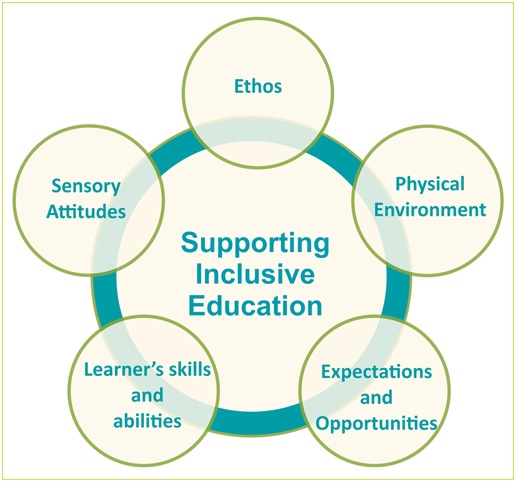7 Strategies To Create Inclusive ESL Classroom Environment For Diverse Learners
28th May 2024

Establishing an inclusive classroom enables all children to experience safety, happiness, and respect in their educational setting. Students may speak with classmates, develop empathy, and learn about a variety of backgrounds and viewpoints in inclusive settings. Teachers should educate themselves, establish clear expectations for students' conduct, exhibit respect, and give opportunities for pupils to exercise empathy to build inclusive classrooms. Teachers may support their students and achieve these aims with the aid of a variety of inclusive classroom practices.
What Is Inclusive Classrooms?
A classroom that supports all children, regardless of their unique needs or learning obstacles, is known as an inclusive classroom. Teachers and other school personnel must give students equitable access to learning opportunities and possibilities for accomplishment in order to create an inclusive learning environment.

Source: open.edu
Creating a climate that is courteous, inviting, and conducive to student comfort is another aspect of creating an inclusive classroom. There are several tactics that educators may use to establish welcoming, content, secure, and meaningful learning environments.
Do you follow us on Social Media? We regularly share upgraded educational content, tips, feedback, and more. Check us out by clicking the profiles here - Facebook / Twitter / LinkedIn / Pinterest / Instagram / YouTube
7 Inclusion Strategies For Diversified Learners In A Classroom
To create an inclusive classroom for your students, here are seven strategies that you can try integrating:
1. Elevate Your Curriculum
Make sure no particular background is left out of your program and that all viewpoints are represented. For instance, all family forms should be covered in family structure education units, and public policy classes should cover themes like racial issues and other social justice concerns.
Use several examples that connect to pupils from different backgrounds while discussing any subject. Furthermore, even if discussing historical events involves delicate subjects, don't shy away from the conversation. Make the most of these instructional opportunities to engage challenging discussions about historical events.
2. Use Inclusive Language
Analyze the language you now use and make sure it is inclusive. For instance, refer to someone using the proper pronouns depending on how they identify. Set an example of inclusive language by refraining from using antiquated or derogatory vocabulary, and confront pupils who use such words. Make use of these situations as teaching moments.
If you utilize American English idioms, make sure to define them for your non-native English speaking pupils.
3. Enforce And create Behaviour And Values
Make brief, easy-to-follow guidelines for kids to abide by. Make sure your kids understand that the rules are there to ensure that everyone feels secure and respected, and that they should abide by them at all times. Enforce your classroom policies by implementing clear, reasonable, and uniform sanctions.
For instance, if you talk over someone else in class, you might have to meet with them afterward. If someone speaks over someone else the first time, you can correct them with a sharp look or a verbal warning; if they do it again, you can write their name down on paper. You can inform them they need to see you after the session if they continue the behavior in spite of these warnings.
4. Create Safe Space For Empathy
Make room for pupils to politely interact with one another; don't coerce them into doing so. This promotes empathy among the kids by enabling them to listen to and learn from one another.
Students can better comprehend their feelings and develop empathy for their peers by using educational mental health information. Students may interact with their classmates more politely if they are taught how to communicate and respect limits.
5. Focus On Global Competence
To establish a classroom that is inclusive of all cultures, integrate global learning into your curriculum. Students that possess global competency are more equipped to learn about the world, appreciate and value different viewpoints, express their thoughts, and take action to change the world.
Teach kids about many cultures, current events, and viewpoints to pique their curiosity about the globe.
6. Avoid Making Stereotypical Assumptions
Refrain from drawing conclusions about your pupils based on preconceived notions, and approach teaching with this perspective. Students with intellectual impairments, for instance, are not inherently stupid, and students who identify as gay are not drawn to every male in the class.
In a similar vein, a distressed female student is not always menstruating. Furthermore, don't pick one kid to speak for or on behalf of the entire class. Students with underrepresented identities may feel more noticeable as a result of this.
7. Educate Yourself
Engage in active student learning and endeavor to further your own professional development as an educator. Try your hardest to break bad habits and preconceptions. Take part in challenging conversations, be informed about social concerns, and learn about other socioeconomic and cultural groups.
Learn the definitions of phrases like ‘white privilege,’ ‘microaggression,’ ‘allyship,’ ‘false equivalency,’ and ‘culturally responsive’ to increase the scope of your knowledge in social justice. Your ability to instruct kids in diversity, social justice, and inclusion will increase as you gain more knowledge in these areas.
Make Your ESL Students Feel Included
All children should feel secure and valued in their learning environment, and inclusive schools make great efforts to achieve this goal. By educating oneself, pursuing offline Online and Live Online TEFL Programs in Vietnam and establishing behavior expectations that uphold respect, teachers may establish inclusive classroom environments.
We believe education should be accessible for everyone. That’s why we don’t charge for our blogs. Find the right course that will help you in your career with us, contact us at - + (+84) 973240969. You can mail us at act@asiancollegeofteachers.com.
Written By : Sanjana